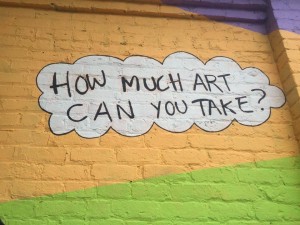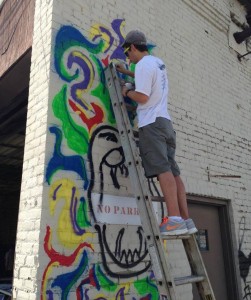2012: End of the World or End of an Era?
Remember 2012? The year the world was supposed to end. A time where Gangnam Style was still a top radio hit. Obama was re-elected as US President and Red Bull sponsored Felix Baumgartner in his 127,00 foot free fall from the sky. 2012 was nothing but dramatic. The year also marks the launch of Richmond, Virginia from a southern city with rich history to a cultural hub of alternative art.
Richmond’s art scene has been growing in line with the growth of VCUArts for years. As VCUArts’ reputation rose, more artists flocked to the city and eventually began to stay. In 2012 though, the arts scene went from just growing to skyrocketing. What caused such a momentum shift? Two major public arts campaigns: RVA Street Art Festival and Richmond Mural Project.
For the longest time, public art in Richmond was a spectacular yet illegal site. Renowned local artist, Ed Trask, is referred to as the pioneer of street art in RVA. Trask started painting the city back in the 1980s when he attended VCUArts. No gallery would accept his work so he decided to use the city walls as a showcase instead. Others followed in his stead: Milk, Broth, Nils and Glass. The illegality of the work made it spontaneous but rare. Yet these artists still made a name for themselves. They continue to paint the city to this day, the only difference is now their work is (mostly) legal.
In 2012, Trask worked to launch the RVA Street Art Festival. The biennial event brings together local and national muralists to recreate drab or rundown public spaces. Past sites include: James River Power Plant and Flood Wall, the old GRTC depot, and Southern States Silos. All benefits from the events go to Art180, a local non-profit who aims to bring art to youth in difficult living situations.
I talked to Dave Ricculli, a student at the University of Richmond who got to participate in the 2013 Street Art Festival. Dave says: “I think street art is part of the amazing fabric of the city that makes it so unique.” As a visitor to Richmond, Dave hasn’t seen Richmond without street art, and it is just one of the many reasons he fell in love with the city.
Dave also talked about one of the focuses of the RVA street art festival. He claims, “It’s more than an art show. It helps bring people together from different parts of the city into areas they might not be familiar with, so that people can realize the potential of how cool the space is and eventually redevelop it.” Dave is referring to areas like Shockoe Bottom and Manchester – areas that are steeped with culture and history but are passed by on a daily basis. Street art brings value to the area.
The original festival helped introduce the concept of public art on a large scale by providing a contained space for locals to view the murals. Like a museum, Richmond natives could visit the festival sites if they wanted to, but most Richmonders would not pass the murals on a daily basis.
The Richmond Mural Project on the other hand sought to disperse public art around the city. The project was launched by DC based art gallery, Art Whino. RMP invites some of the world’s hottest talent to the Virginia city. The whole point of the project is to curate one of the world’s premier street art galleries along the city walls. No neighborhood is missed – the whole city is a museum now. Shane Pomajambo of Art Whino convinced the Richmond City Council and Mayor’s Office to support the project by claiming an increase in art tourism will increase the number of foot traffic visiting local businesses. Pomajambo’s reasoning is sound, but the project’s real impact is cultural.
Through RMP alone, 38 artists have painted over 75 murals around the city. At least fifteen more are expected through this year’s rendition of the project. You cannot drive through the heart of Richmond without seeing a few murals along the way. Unlike the festival sites, locals cannot avoid RMP murals. They are anywhere and everywhere.
These murals, the festivals, VCUArts and the growth in other public arts projects has cultivated a well-respected art scene in the city. Somewhat of a surprise considering the history and tradition typically mentioned in reference to the southern city. 2012 might not have marked the end of the world, but it marks the beginning of a new era in Richmond history.
By: Beaumont Smith
Below is a map I created of mural locations for the Richmond Mural Project. You can click each location to see the year, date, neighborhood, and business site.



